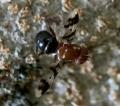Diptera.info :: Identification queries :: Diptera (adults)
Who is here? 1 guest(s)
|
Ectophasia sp
|
|
| Arthropa |
Posted on 27-04-2007 20:28
|
|
Member Location: Fragnes (Burgundy, France) Posts: 183 Joined: 15.06.04 |
Hi, I'd like to know more about genus Ectophasia... Anywhere you have a look, you always and ever see E. crassipennis, but never other species (i.e. E. oblonga and E. leucoptera for France, according to Fauna Europaea). Here is one I found in Ahetze, near Biarritz in France, on 14th august 2006. Wingspan was 13 mm, body length 11 mm.   Is it possible to identify ? Which criterions can help distinguishing crassipennis from others ? Thanks ! 
Benoit MARTHA  |
| ChrisR |
Posted on 27-04-2007 21:36
|
|
Super Administrator Location: Reading, England Posts: 7703 Joined: 12.07.04 |
Hi I don't know leucoptera because it occurs outside the area of the Central European key but crassipennis and oblonga can be split using this key thus: 1. Haustellum long (3.5 - 5.5x as long as its diameter). Females: sternite 7 bent forwards (fig. 228). Males (typical specimens): abdomen not or hardly longer than wide, colouring yellow with a black central longitudinal stripe, which is at least as wide as 1/5 of the abdomen (fig. 171); sternite 3 at least as wide as the ventral membrane bordering it; thorax before the scutellum often blackish, but ? densely dusted; abdomen occasionally completely black......crassipennis F. - Haustellum shorter (2.8 - 5.2x as long as its diameter). Females: sternite 7 bent backwards a little at the end (fig. 227). Males (typical specimens): abdomen clearly longer than wide, colouring red with a black central longitudinal stripe (maximum 1/8 of abdomen width), which is sometimes missing completely; sternite 3 narrower than the ventral membrane (fig. 183); thorax before the scutellum shiny black, at this spot seldom with a little dusting; gynaecomorphous specimens with evenly dense abdominal dusting seem to occur almost only in this species; darkening of the abdomen is rare.......oblonga R.D. Hope that helps  |
| Arthropa |
Posted on 27-04-2007 22:21
|
|
Member Location: Fragnes (Burgundy, France) Posts: 183 Joined: 15.06.04 |
Thanks !  This seems to rule out oblonga. Just what about leucoptera ?... Who knows ? Edited by Arthropa on 27-04-2007 22:21 Benoit MARTHA  |
| Stephane Lebrun |
Posted on 27-04-2007 22:44
|
|
Member Location: Le Havre, France Posts: 8248 Joined: 03.03.07 |
Benoit, a recent thread about E. leucoptera here . Stephane. |
|
|
|
| Arthropa |
Posted on 03-05-2007 21:38
|
|
Member Location: Fragnes (Burgundy, France) Posts: 183 Joined: 15.06.04 |
Well, mine should then be E. crassipennis. Thanks for your help ! 
Benoit MARTHA  |
| Zeegers |
Posted on 04-05-2007 07:48
|
|
Member Location: Soest, NL Posts: 18921 Joined: 21.07.04 |
Why do you rule out oblonga ? It is a female, isn't it ?? It's not leucoptera, the male is very typical and the female has uniformely smoky wings. Also very typical. It's either crassipennis or oblonga and the abdomen is somewhat elongated, so .... one of those Theo |
|
|
|
| Arthropa |
Posted on 05-05-2007 23:25
|
|
Member Location: Fragnes (Burgundy, France) Posts: 183 Joined: 15.06.04 |
Well, indeed, I guess I misunderstood the key to species Chris Raper gave us.  So, it will remain Ectophasia sp, possibly E. crassipennis or E. oblonga. Thanks to all ! 
Edited by Arthropa on 05-05-2007 23:26 Benoit MARTHA  |
| Jump to Forum: |













